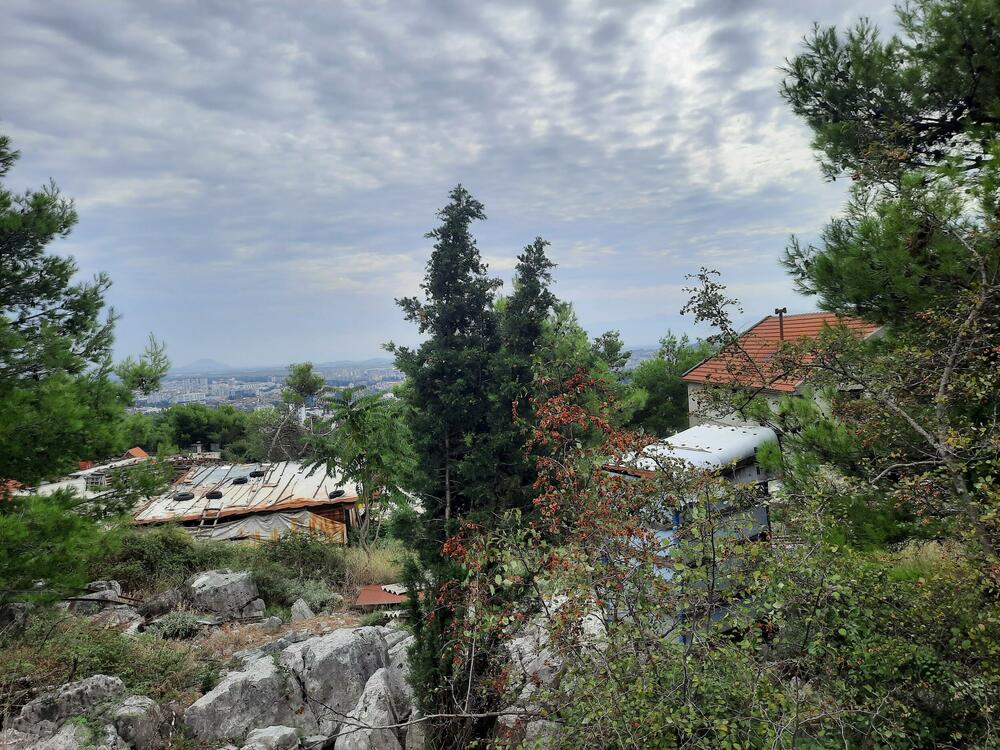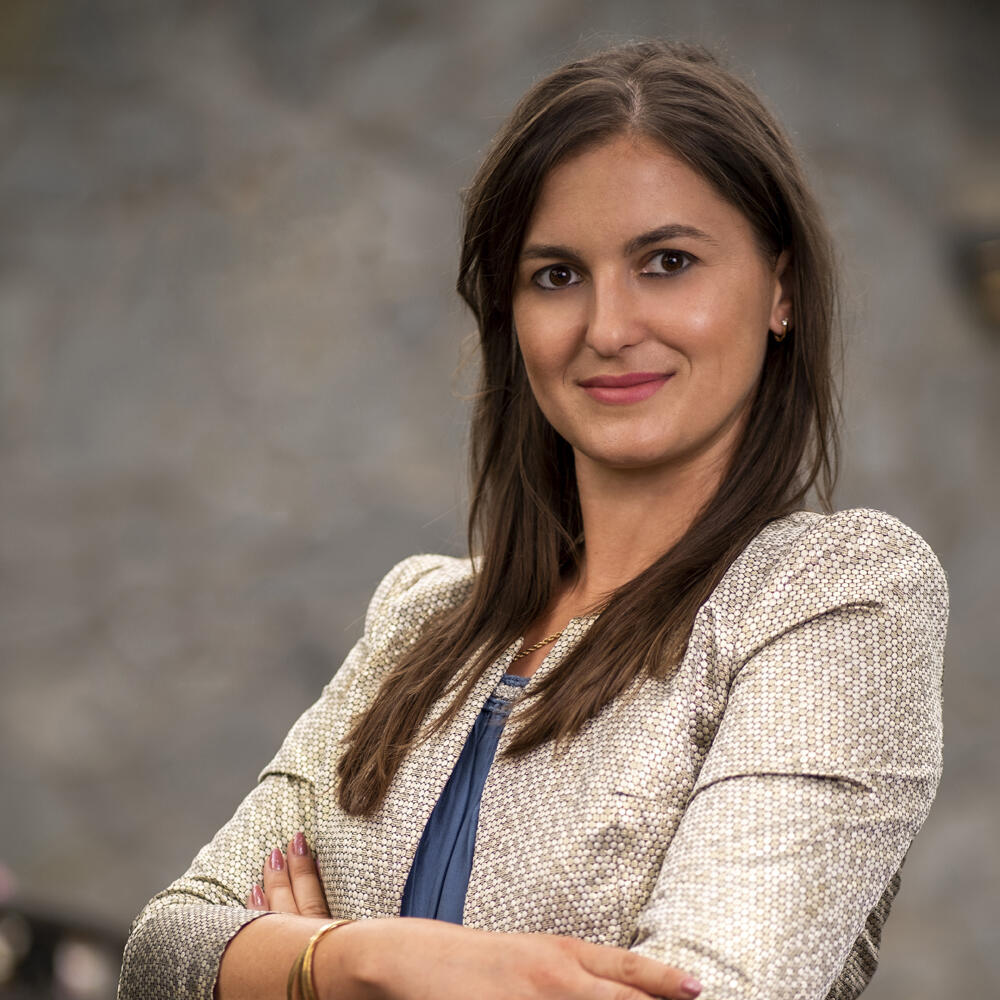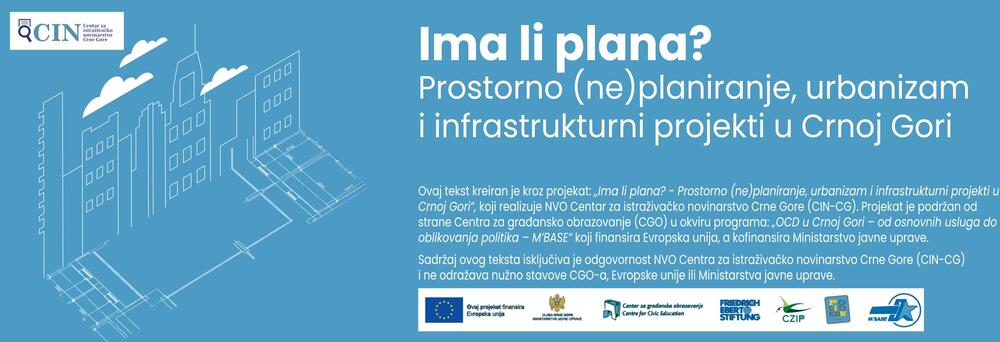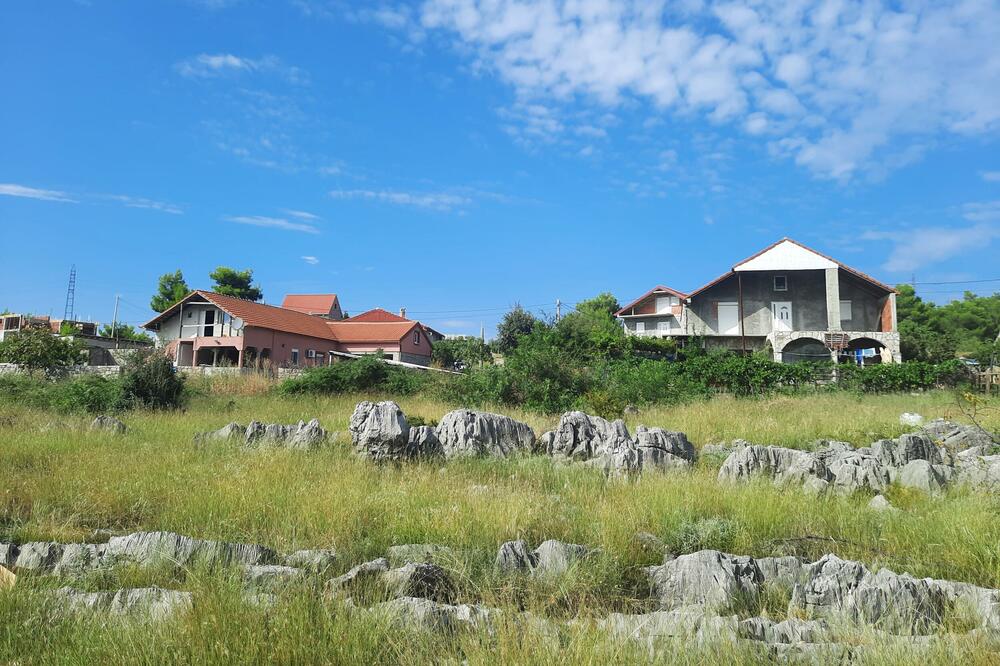I was pregnant when we built this house, I carried bricks, we collected rainwater to have water, we used a mace to break stone to have a place to live. Now the whole family has problems with their spine, says Ljiljana Jokić, one of the owners of an illegally built house on Mali Brdo, a settlement in Podgorica, which is located on the hills above the Preko Morača part of town.
The upper part of this settlement, where Ljiljana lives, can be reached by a macadam road, along bushes and rocks on both sides of the road, which testify that there used to be a quarry there. The owners of about fifty houses have been waiting for years for the promises of local officials to be fulfilled, who usually come before the elections to promise them that, well, the water has just arrived.
Jokic for Center for Investigative Journalism of Montenegro (CIN-CG) says that even today that part of the settlement does not have water or functional roads. Her house, which was built on municipal land back in 2004 without the necessary permits, was reported to the Podgorica cadastre immediately after they moved in in 2005. Since then, they regularly paid taxes and electricity. And garbage collection, for containers that are a kilometer away from the house. Residents of this part of Mali Brdo, in order to legalize their houses, now need, among other things, to pay 132 euros per square meter for the land on which the house was illegally built.
There are more "wild settlements" in Podgorica alone, with tens of thousands of illegal houses, built by occupying state, municipal, and private land - in Zagorič Forest Park, Kakaricka Gora, Dajbabska Gora, on Mali Brdo...

In Montenegro, according to the estimate of the Ministry of Ecology, Spatial Planning and Urbanism (MEPPU), there are over 60.000 illegal buildings, and since 2017, when the decision was made to legalize illegally built buildings, the state has failed to solve the problem. Illegal construction continued. In six years, only 2.818 buildings were legalized, out of about 52.000 registered for legalization.
The Law on Spatial Planning and Building Construction from 2017, which also dealt with the legalization procedure, is now being changed and transformed into three laws, one of which should only deal with the issue of illegal construction.
Citizens who are supposed to legalize buildings are afraid that new legal solutions could endanger sensitive sections of the population, who will not be able to solve problems, because large sums of money are required for legalization in certain settlements.
"This is an experiment of the state that we don't know how it will end," Dr. Milica Vujošević from the organization KANA (Who if not an architect) points out for CIN-CG.
She points out that the problem of illegal buildings is of a systemic nature and cannot be solved by a single law. He reminds that the law already exists, but that its implementation and resolution of social and spatial problems are not at a satisfactory level. He believes that the new law should be adopted as soon as possible and reminds that the public discussion ended in May.

The Ministry estimates that at least 150 million euros could be collected from the legalization process, if everyone accepts the conditions, which are foreseen by the new legal solutions.
And the conditions are to submit a request for legalization with a completed and certified report, which costs from a few hundred euros and up, depending on the size of the facility.
Then it is necessary to pay a fee for urban rehabilitation, that is, what would be "utilities" for legal builders. The amount of that fee was determined by the municipalities.
Thus, according to the Decision on compensation for urban rehabilitation, which was adopted by the Podgorica municipality in 2020, this compensation ranges from a little less than 142 euros per square meter in the most expensive zone, to a little less than 49 euros in the cheapest zone. This fee is reduced by 50 percent for basic housing in illegal buildings, 80 percent for auxiliary buildings within the house, and 90 percent for social cases.
A square meter on Mali Brdo costs 132 euros
According to that decision, for the urban renovation of a house of 100 square meters, residents of Mali Brdo should pay about 5.000 euros, if they live in it. If they don't live, they pay double the price.
A much bigger problem for them is the repayment of the land, which is estimated at 132 euros per square meter. Which means that you need to pay about 600 euros for a plot of 80.000 square meters. The land can be repaid in installments over a period of 30 years, if it is used for housing.
"No one escapes from paying, we have all been trying to legalize houses for years, but we must have basic conditions for living and that these be realistic prices, not the prices of houses in Dubrovnik," says Ljilja's neighbor, Miško Šćekić.
He also points out that the area on which houses were built in this settlement was a rocky field, and that those who built there turned it into arable land.
"The new law is even worse than the previous one, this has no chance of coming to life, if their goal is to legalize illegally built buildings, which we have all been trying for years, the cost of the entire procedure would have to be reduced," points out Gordan Grdinić from this settlement.
He explains that in that part of Mali Brdo there are mostly refugees and people from the north, who had nowhere to live, and that they cannot pay so much money for legalization.
In addition, as a guarantee that they will repay the land, they must pledge something worth 30 percent more than the land.
"The only thing we can and have to pledge is that illegal house, which cannot possibly be worth that much," explains Grdinić.
Grdinić emphasizes that he will organize and demand that legalization be available for everyone.
The representative of the KANA organization, Milica Vujošević, points out that illegal construction is a problem that can be very difficult to solve to everyone's satisfaction, so it is logical that solving this issue is met with resistance.
She believes that, when it comes to sensitive categories of the population, this problem should be solved through social assistance and the like. However, he warns that among the illegal builders there are many transitional profiteers, who violated the laws in order to gain benefits.
"The problem of illegal construction is not only related to vulnerable categories of the population, but also to many who built for the sake of profit, selling real estate, so that practice must be stopped once and for all," emphasizes Vujošević.
And whether this also applies to the illegally built buildings of the former head of state Milo Đukanović, the former mayor of Budva Marko Bata Carević or the Serbian Orthodox Church (SPC) remains to be seen.
The demolition of two illegal houses of Đukanović, in a village close to Nikšić, was announced noisily two days after the election, in which he lost the presidency, in April this year. But that didn't happen. According to the Spatial-Urban Plan (PUP) Nikšić, these buildings are located in the green belt where the construction of residential buildings is not allowed.
The Network for the Affirmation of the Non-Governmental Sector (MANS) accused Tsarević of usurping around half a million square meters of state land in Krimovica, near Budva. He still uses it all without problem.
Among the illegal builders is the SPC, which is building a temple on state land next to the Captain's Lake in Kolašin, and previously built a baptistery near Tivat, a metal church in Rumija... No one touches them either.
They will demolish in protected zones and where infrastructure is planned
The State Secretary of the Ministry, Zorica Krsmanović, emphasizes for CIN-CG that strict attention will be paid to whether illegal objects are built in places where some infrastructure project is planned, in protected zones, within the scope of National Parks, where they can be legalized only in accordance with plan.
"Of course you shouldn't build a villa of 500 square meters in protected areas, it will all collapse," Krsmanović points out.
She clarifies that anyone can apply for legalization under the current law:
"The essence is to force the owners of illegal buildings to register and for the buildings to enter the cadastral records."
The Ministry states that the money collected from urban rehabilitation will be invested in the settlements of those who gave it:
"The results of the legalization process must be visible, through the improvement of living conditions in those areas, the improvement of communal infrastructure, the construction of missing facilities, and the success of law enforcement depends on the response of illegal builders who will enter the process."
After 2018, builders will pay a fee for using the space
In the Draft Law, it is written that only buildings located on the so-called ortho-photo recording, which proves that the buildings were built by October 2018.
Homes that are not on that October 2018 snapshot cannot enter the legalization process.
The largest number of the 333 objections received on the Draft Law refers precisely to the requirements that the legalization should include objects that are not on the ortho-photograph. The public also complains about the amount of fees for legalization and the deadlines for starting the legalization procedure.
In the remarks, it is pointed out that the state, among other things, cannot limit legalization only to the period until 2018, when it has not yet adopted planning documents.
MEPPU, which is headed by Ana Novaković Đurović, considered allowing the legalization of objects that are not on the video, but in the end it was abandoned, as they claim for CIN-CG.
Vujošević from the KANA organization points out that, when drafting the draft law, the Ministry was explicit that buildings built after October 2018 are not taken into account, because that would mean that it is actually okay to work illegally, because that building will certainly be legalized at some point.
"Everyone was warned before 2018 not to build illegally, because their building will not be considered, so they did it again. It is not about a period of transition and solving the need for housing and a roof over one's head, but rather about arrogance and the intentional commission of a criminal act, which illegal construction is," emphasizes Vujošević.
She assesses that the state should stand in the way of this, but fears that it will give in "under the pressure of big builders and known violators of the law, rather than out of sympathy for socially vulnerable categories".
However, in a conversation with a CIN-CG journalist, the Ministry stated that they would not allow it.
"We are all witnesses that he was building, and who didn't think he was building, in order to enter the ortho-photo recording, because it is cheaper for them to legalize the buildings later, than to work legally", the director of the Directorate for Housing Development and Legalization explains for CIN-CG Radmila Lainović.
The reality is that a large number of buildings were built after the ortho-photo.
"If we remove ortho-photo as a criterion, we give the signal that there are no borders. By doing so, we would allow illegal builders to create our space", she explains.
However, they will not demolish those buildings, if they are for residential purposes and are not located on the infrastructure, but they will have to pay a fee for using the space.
The Ministry claims that it is almost impossible to misuse ortho-photos:
"I don't believe anyone will risk their license and criminal charges because of that."
The ortho-photo recording is not yet available on the website of the Ministry.
Protector: Draft law contrary to the Constitution and EU directives
The protector of property and legal interests in his comments on the Draft Law warns that it is in conflict with the Constitution and other regulations, as well as some EU directives.
They also point out that the explanation of that regulation does not contain clear arguments why the legalization of illegal buildings is in the public interest. They add that there is no data and analysis that will convince the public that there will be an inflow into the budget, that these funds will be intended for the development of infrastructure and a better standard of citizens, but also that the environment will not be endangered.
"The fact that illegal construction is a criminal offense prescribed by the Criminal Code (CC) should be especially appreciated. In addition, illegal builders are placed in a more favorable position compared to those who respect the laws and procedures", the protector's office emphasizes.
They also point out that according to the Constitution, the Law on State Property and the Law on Property-Legal Relations, it is prescribed that goods of general interest cannot be private property. They also warn that the prescribed legalization of buildings in protected zones also contradicts the Constitution, EU laws and directives, and that it includes several criminal acts.
They conclude that the draft Law is unsustainable and must be returned for revision.
However, the Ministry does not accept the objections of the protector, stating, among other things, that no special explanation is needed for the intention to solve the problem of illegal construction, and that it is not possible to remove all illegally erected buildings without consequences.
In response to the submitted comments, the Ministry explains that buildings in protected zones can only be legalized if they are built in accordance with the planning document:
"Construction is also allowed in these zones, but it must be in accordance with the rules."
The Draft Law also proposes the formation of a state agency that will be established for five years and whose sole task would be to deal with the legalization of facilities.
"The local self-government units have not solved even one percent of the submitted applications for legalization in five years", is the Ministry's explanation for establishing the agency.
The Ministry points out that there is no accurate record of the number of illegal buildings, and that local self-governments have not completed this work either.
"If we also include the illegal upgrading of existing buildings, that figure of 60.000 is certainly higher, but those buildings are a much smaller problem," Lainović assessed.
The Ministry adds that local self-governments have not yet made records of how many of these buildings are used for housing.
"Local self-governments often do not have the capacity to complete all of this, especially now that the creation of local plans will return to their jurisdiction," explains Krsmanović.
She adds that all illegal buildings over 500 square meters will be processed by the agency. For buildings over 500 square meters, it will be necessary to prepare a Static and Seismic Activity Report:
"If after a year we see that the municipalities have not solved even 20 percent of the requests, the Agency will take over part of the work, but then the state will receive income from it, not the municipalities."
Vujošević believes that the establishment of an agency at the state level is not a bad idea, since the municipalities complained that they could not manage to process as many cases as there are illegal constructions.
The fact is, concludes Vujošević, that this trend must somehow be stopped, and whether and to what extent the new law will succeed and what its application will be, remains to be seen.
"Nobody escapes from payment, but at realistic prices. If not, let them hug us on the hill with an excavator, both us and the house", says Ljiljana Jokić, who would like to legalize the house, but also to pay the fee for permits and the land, which are rational.
Croatia banned legalization after 2011.
Lainović points out that in Croatia in 2011, a cross-section of the situation was made and only what had been done until then was legalized.
In Macedonia, a section was made, but only in order to register the objects in the cadastre, and not to legalize them, and it cost a euro.
She points out that nobody's goal is to demolish the houses of the people who live in them, but that some order must be introduced and those who build illegally must be punished.
"Illegal builders cannot be given more rights than legal ones," Lainović points out.
No issuing of illegal objects
The draft law prohibits engaging in activities in illegal facilities. Lainović explains that they have banned the operation of illegal facilities:
"So people submit a request for legalization in May, and in October they give up, so that they can issue it, we will ban that," she points out.
The Law also leaves a deadline of six months to submit a request for legalization, and the Law is passed for five years, by which time the legalization of all illegal buildings must be completed.
"It is clear to us that many people built houses out of necessity, that's why we recognized the category of basic housing and this is treated separately in relation to those whose house is used exclusively for renting out at 200,300 meters from the sea", says Krsmanović.

Bonus video:




